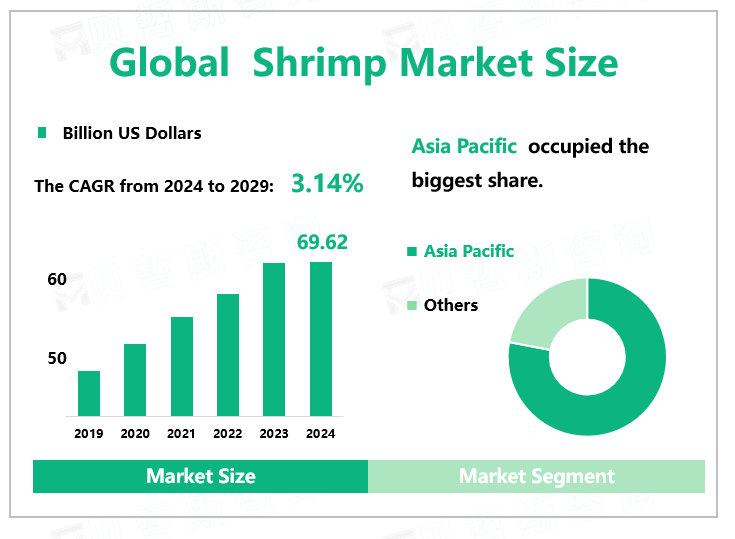Global Shrimp Market Overview
According to Global Market Monitor, the global shrimp market will reach $69.62 billion in 2024 with a CAGR of 3.14% from 2024 to 2029.
The Demand for Shrimp is Rising.
Shrimp is considered a low-fat, high-protein alternative to other meats, which makes it a popular choice. The global demand for seafood, including shrimp, is rising due to changing dietary preferences and increasing consumer health consciousness. In addition, consumer awareness about the health benefits of consuming seafood, particularly shrimp, has increased. According to the study “The State of World Fisheries and Aquaculture 2022”, published by the Food and Agriculture Organization (FAO), there has been a consistent annual growth rate of 3% in global consumption of aquatic foods (excluding algae) since 1961.
Market Dynamics
The Global Seafood (Prawn) Trade Festival will be held in Zhanjiang and Guangzhou China respectively from June 18 to June 22. This trade festival is not only an exhibition to display seafood and aquatic products, but also a collision and integration of industry wisdom, aiming to create a platform for communication, cooperation, and development for domestic and foreign aquatic enterprises and professional audiences.

Asia Pacific is the Largest Market.
Seafood consumption varies widely across regions, with countries bordering oceans consuming more seafood than landlocked nations. Asia is the largest consumer of seafood globally, driven by its large population and cultural preferences for seafood. Asia Pacific countries have made significant advancements in shrimp aquaculture technology and practices. This has led to increased production, improved quality, and cost-effective shrimp farming. In April 2023, Kemin AquaScience, headquartered in the U.S. introduced Pathorol to enhance farmed shrimp health across multiple Asian nations. Pathorol, a shrimp dietary supplement is designed to enhance the health of the hepatopancreas, a vital organ in the digestive tract of crustaceans. The product is now available in India, Thailand, Vietnam, Indonesia, and Singapore. Healthier shrimp are likely to result in higher-quality shrimp products, which can command better prices in the market, boosting sales.
The Globalization of Cuisine Drives Market Development.
The rapid globalization of cuisine, which has introduced an array of international flavors and ingredients to a wider audience, is propelling the market growth. In line with this, the widespread product adoption in various cultural dishes, such as curry, cocktail, stir-fry, tacos, ceviche, bisque, pasta, fried rice, and sauces, is contributing to the market growth. Furthermore, the increasing consumer exposure to different cuisines, such as Asian, Mediterranean, and Latin American, where prawns are prominently featured, is positively influencing the market growth. Additionally, the growing impact of traveling, international restaurants, cooking shows, and social media on consumers' dietary preferences and exposure to prawns is supporting the market growth. Apart from this, the increasing acceptance and demand for prawn-based meals across diverse geographic and cultural landscapes is favoring the market growth.
|
S |
Increasing downstream demand |
|
Mature industry chain |
|
|
Good purchasing power |
|
|
W |
Fierce competition |
|
High labor cost |
|
|
O |
Changes in political, economic, social, technological, legal, and environmental factors boost the market |
|
Potential market growth |
|
|
T |
New entrants find it hard to open the market |
|
Regulation from Government |
We provide more professional and intelligent market reports to complement your business decisions.